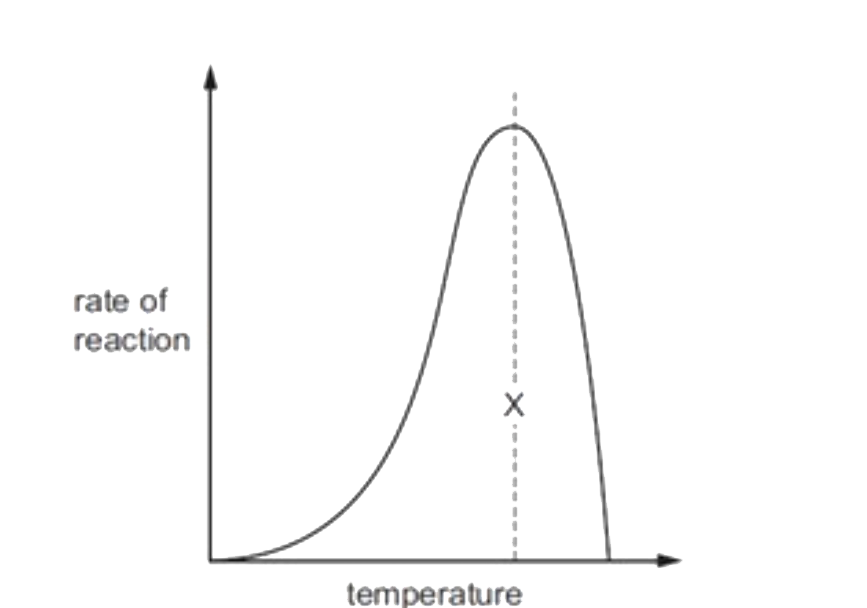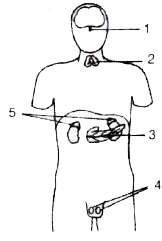The diagram shows the effect of an enzyme working in the human digestive system .
 enzymeatPH1.5−−−−−−−−−−−−−−→and temperature at37∘C
enzymeatPH1.5−−−−−−−−−−−−−−→and temperature at37∘C
What would reduce the rate of production of amino acids ?
removing the amino acids as they are formed
increasing the amount of protein
raising the temperature to 37.1∘C
raising the pH to 4.5
The correct Answer is:D
Step by step video & image solution for The diagram shows the effect of an enzyme working in the human digestive system . underset("and temperature at" 37^@C)overset("enzyme at PH1.5)rarr What would reduce the rate of production of amino acids ? by Biology experts to help you in doubts & scoring excellent marks in Class 12 exams.
Updated on:21/07/2023Similar Questions
The graph shows the effect of temperature on the rate at which the enzyme in a biological washing powder digests and removes fruit juice stains .

Which statements explain the shape of the graph at temperatures higher than X ?
I. Bonds are broken between the R groups of the amino acids in the polypeptide chains of the enzyme.
II. There are more collisions between the enzyme and its substrate.
III. The tertiary structure of the enzyme is altered.
Iv. The shapes of the active site and the substrate are no longer complementary .
View SolutionEnzymes work at optimum temperature. Over a range 0−40∘C, what would happen to the rate of enzyme controlled reactions for every 10∘C rise in temperature ?
View Solution
Knowledge Check
During the process of digestion, the proteins present in food materials are hydrolysed to amino acids. The two enzymes involved in the process are:
Enzyme (A)−−−−−−→ Polypeptides
−−−−−−→Enzyme (B)Amino acidsAinvertase and zymaseBamylase and maltaseCdiastase and lipaseDpepsin and trypsin
Following are two first order reaction with their half times given at 25∘C.
At1/2=30min−−−−−−−→ Products
Bt1/2=40min−−−−−−−→ Products
The temperature coefficients of their reactions rates are 3 and 2, respectively, beween 25∘C and 35∘C. IF the above two resctions are carried out taking 0.4M of each reactant but at different temperatures: 25∘C for the first order reaction and 35∘C for the second order reaction, find the ratio of the concentrations of A and B after an hour.
View SolutionFig shows a cylindrical tube of volume V with adiabatic walls containing an ideal gas. The internal energy of this ideal gas is given by 1.5nRT. The tube is divided into two equal parts by a fixed diathermic wall. Initially, the pressure and the temperature are p1,T1 on the left and p2,T2 on the right. the system is left for sufficient time so that the temperature becomes equal on the two sides. (a) how much work has been done by the gas on the left part ? (b) find the final pressures on the two sides. (c ) find the final equilibrium temperature. (d) how much heat has flown from the gas on the right to the gas on the left ?

View SolutionThe first order reaction has k=1.5×10−6 per second at 200∘C . If the reaction is allowed to ruf for 10 hours at the same temperature, what percentage of the initial concentration would have changed into the product? What is the half life period of this reaction ?
View SolutionThe given diagram is an outline of human body showing the posttion of certain organs. In this diagram
(I) Name the parts labelled 1-5.
(ii) Name the hormone released from 1 that influences the working of part 2.
(iil) How do part labelled as 3 differs from parts labelled as 1 and 2 in general? Name the endocrine cells present in part 3.
(iv) What will happen if the part labelled as 4 is removed ?
(11) Name the hormones released by part 5.
(VI) Why the part labelled as 1 called master gland? Which part of the forebrain controls the gland labelled 1 ?
(vii) Name the gland that secretes 'emergency hormone.

View SolutionCO2 and H2O absorbs strongly in the infrared rrgion and its presence in the atmospheere dectrases the loss fo heat form the enrth by radistiion . This global warming is called the greenhouse effect (other gases , including the oxides of nitraongen form car exhauset freons from aerosols and refrigeratirs and methane from bacteria in the soil and in the rument cows , also add to the reeenhouse effect ). The concentration fo atmospheric CO2 has increased by 10% . The is rsulting in the increase in the mean temperature fo the earth by 2.5∘C, varying form 2∘C t the equlator to 4∘C at the poles . This could have dramatic effects on the climate.
The equilibrium constant (Kp) for the reaction
2CO(g)−−→←−−2CO2(g)
is 1.4×1090 at 25∘C . Given this enormous value, why does not CO convert totally into CO2 in the troposphere?.
View SolutionThe following is not an appropriate reaction for the preparation of t-butyl ethyl ether.
C2H5ONa+CH3−CH3| C| CH3−Cl→CH3CH3| C| CH3−OC2H5
(i) What would be the major product of this reaction ?
(ii) Write a suitable reaction for the preparation of t-butylethyl ether.
View SolutionWhen pinacol is treated with dilute H2SO4, a re-arangement reaction takes place which leads to the formation of a ketone.
CH3−OH∣C∣CH3−OHC∣CH3−CH3H2SO4−−−→CH3−O∣∣C∣CH3−CH3∣C−CH5
This reaction involves re-arrangement of carbocation
Step 1:
_S01_409_Q01.png)
CH3−OH∣C∣CH3−+OH2∣CCH3−CH2→CH3−OH∣C∣CH3−OH∣C∣CH3−+C∣CH3−CH3
Step 2:
Carbocation rearrange by hydride, alkyl shift to get as stable as they can. Stability is the driving force for re-arrangement migration of bond may also oC Cur. Where by ring expansion and ring contraction takes place. The relief of strain can provide a powerful driving force for re-arrangement.
_S01_409_Q02.png)
_S01_409_Q03.png)
What will be the product of following reaction
_S01_409_Q04.png)
R is:
View Solution
